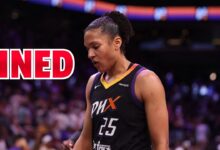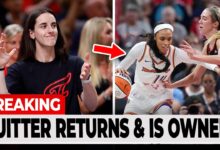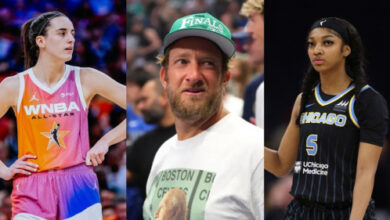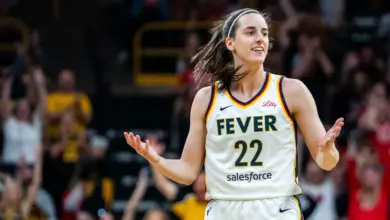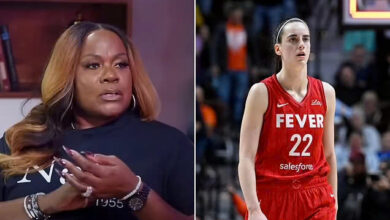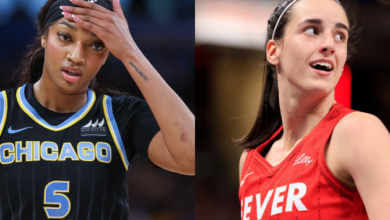Clarkonomics: Dissecting the complexity of paying Caitlin Clark what she’s really worth
INDIANAPOLIS — Dr. Ryan Brewer is a renowned valuation guru in the field of finance. He is an expert on estimating something or someone’s worth. His professional opinion is so revered that he has been called on to testify in court as a valuation expert, including cases involving sports property.
In his research, he has crunched the numbers, one way or another, for just about every major sports league. He has delved into college and youth sports, too.
But when IndyStar asked Brewer to put a price tag on Caitlin Clark — what she has meant financially to the WNBA, her city and the country in her rookie season with the Indiana Fever — the numbers were so shocking that Brewer was sure he must have made some mistake.
He ran the numbers again. Then again. And every single time, he got the same result.
“The numbers are so staggering,” said Brewer, associate professor of finance at Indiana University Columbus. “They don’t even seem real.”
By Brewer’s calculation, Clark is responsible for 26.5% of the WNBA’s leaguewide activity for the 2024 season, including attendance, merchandise sales and television. One of every six tickets sold at a WNBA arena can be attributed to Clark.
Total TV viewership due to Clark is up 300% and 45% of total broadcast value came from Fever games. The league’s merchandise sales catapulted 500%, with Clark ranking No. 1 followed by the Chicago Sky’s Angel Reese, another rookie.
The Fever’s regular-season game attendance averaged more than 17,000 fans, the first time a WNBA team has drawn more than 300,000 fans in a season. Clark’s regular-season games were watched by 1.2 million viewers on average, which was 199% more than non-Clark WNBA games.
But, perhaps, the most astonishing number of all is Clark’s economic impact on the city of Indianapolis, which Brewer says is upwards of $36 million. Not as big as the NBA All-Star game’s $400 million financial boost to the city in February, but a respectable 10% of that.
“Now, let’s take a breath for a minute and think about this,” said Brewer. “That’s for one year. We’re talking about one player.”
One player who came into a league that had slowly been growing and ignited a firestorm of popularity. A player who was paid an annual salary of $76,535, a fraction of what she made for her league. A player whose male rookie counterpart Victor Wembanyama was paid $13.8 million his first season in the NBA, a whopping 184 times more than Clark.
All of it begs the question — a complicated, multilayered question that involves lessons in business, marketing, risks, rewards and economic impact. Will Clark ever be paid by the WNBA what she’s really worth to the league?
“Yes, it would make a ton of sense for Indianapolis to lock her up long-term at a million dollars a year,” said John Holden, associate professor of business law and ethics at the Indiana University Kelley School of Business. “But the Fever and the WNBA can’t just go out and give these deals, even if that’s what market value for Caitlin Clark’s playing would be worth.”
There is, after all, the WNBA’s collective bargaining agreement, which puts a cap on what a rookie can be paid — Clark’s $76,535 salary. No matter how much Clark has affected her league and the popularity of women’s basketball nationwide, no matter how much money she’s racking up for a pro sport that for years was floundering, it’s a cut and dry issue.
Whether that will change in the future depends on if the wave of interest in the league sustains, rises or drops off. Whether TV contracts can be re-negotiated, whether a higher percentage of revenues can be directed toward players and whether the capitalist market that pro sports exists in is willing to take a risk.
“As this continues to materialize, the corporate side, the business side, not the players union, but the other sides, are going to continue to watch to see that these numbers can stabilize and maintain rather than just spike and drop again,” said Brewer. “That’s what they’re afraid of. And that’s what’s keeping the numbers low.”
‘Clark was never going to make LeBron James money’
The WNBA Players Association doesn’t want to continue to watch and wait. They want things to change and quickly.
Hours after the 2024 season ended with the New York Liberty winning the championship in a 67-62 overtime Game 5 against the Minnesota Lynx, the players association announced it would opt out of the 2020 collective bargaining agreement, which was set to expire in 2027.
The move ends the terms of that agreement after the 2025 season, a contract that set the league’s minimum annual salary at $64,154 with a maximum of $241,984, adding up to average base salaries for players at about $120,000.
For Clark, her four-year rookie contract under the CBA was worth $338,056 on a scale that assigns specific salaries based on draft positions.
The top four picks in the 2024 draft, for example, were guaranteed a base salary of $76,535 in their first year, with No. 2 pick Cameron Brink of the Los Angeles Sparks, No. 3 Kamilla Cardoso of the Sky and No. 4 Rickea Jackson with the Sparks earning the same salary as Clark.
Before the draft, WNBA commissioner Cathy Engelbert called the four women a part of a class loaded with “household names.” They didn’t disappoint.

As the season played out, not only were on-court statistical records shattered — with Clark breaking almost every rookie record during her first year — but so were off-court stats. In addition to explosive growth in attendance, television ratings and interest from sponsors, the WNBA signed a new media rights deal in July worth a reported $200 million a year, more than three times the current package.
The league is also experiencing unprecedented growth in franchising, adding three teams in a matter of two years to its current 12-team roster.
The Golden State Valkyries, which paid a $50 million expansion fee in October 2023, a league record at the time, will debut in 2025. A year later, that figure more than doubled when the WNBA added Portland — $125 million — and Toronto — $115 million — for the 2026 season.
Still, with league revenue projected at $200 million, according to Bloomberg, less than 10%, or $20 million, of that goes to player salaries. NBA players share 50% of their league revenue, which was $10.6 billion in 2023, or $5.3 billion.
“If you look at where the NBA is at and the NFL and the NHL, that’s probably the best benchmark, not actual dollar numbers, but share of revenue,” said Holden. “And most of the men’s pro leagues are at a 47% to 51% share so very close to 50-50, and I think that’s where a lot of fans and players of the WNBA would like to see things go in the future.”
Clark’s salary in the whole scheme of things, “is a tiny number,” said Victor Matheson, professor of economics at the College of the Holy Cross in Worcester, Mass, who specializes in sports economics.
“Caitlin Clark was never going to make LeBron James money, even in the best world,” he said. “But in a world where the WNBA players were making similar percentages of the revenue generated, you would see salaries in the WNBA easily double and maybe more than that.”
Jealousy, fear, respect:How Caitlin Clark’s been treated by WNBA players is complicated
‘If you want us to be here, you have to pay us more’
Opting out of the current collective bargaining agreement was the first step toward making that happen, according to the players association, which posted a video to X with the motto: “It’s business. We’re out.”
Among the players in the video were New York’s Breanna Stewart and the Seattle Storm’s Gabby Williams, who in September spoke out about the league’s paltry pay.
“The W thinks that they don’t have to pay us more in order for us to be here … our commissioner talked about us being able to, you know, make $700,000. That’s actually, that’s not true at all,” Williams said. “There’s not one player who makes that.”
The highest-paid player in 2024 was Las Vegas Aces shooting guard Jackie Young, who garnered a salary of $252,450, followed by the Storm’s Jewell Loyd, $245,508, and the Phoenix Mercury’s Kahleah Copper, $245,059, according to Spotrac. Those base salaries do not include endorsements or other sponsorship dollars.
The league promised some players team marketing agreements and legal marketing agreements, according to Williams, “but they’ve fallen quite short.”
“So, it’s still not enough for us international players to want to stay here. And that’s a choice of the players. If I make a choice to make more money and then the teams are mad that I don’t come back? That’s how it is,” she said. “So yes, it’s just the WNBA, if you want us to be here, you have to pay us more. It’s business. It’s how it works.”
The WNBA declined to respond to questions from IndyStar about the league’s salaries.
During the league’s six-month offseason, it’s common for WNBA players to go overseas to play in Turkey, China, Italy, Spain and other European countries. Others stay stateside for player-led leagues like Athletes Unlimited or Unrivaled.

Clark, a financial outlier in the league, isn’t playing professionally during the break and she doesn’t need to. In addition to an eight-year, $28 million deal with Nike, which gives her $3.5 million a year from the shoe company alone, she also has deals with insurance agency State Farm, appearing in nationwide commercials, HyVee, Gatorade, Wilson, Gainbridge, Xfinity and Buick.
While the specific numbers of those deals are unknown, economists predict Clark brings in millions more from those deals.
“Her salary from the WNBA is background noise to her annual income and it should be because she’s a national, maybe global, superstar,” said Michael Hicks, professor of economics and the director of the Center for Business and Economic Research at Ball State University. “The money that she’s making from playing for the WNBA, it is almost irrelevant to her economic vitality.”
Other players in the league aren’t landing Clark-esque deals worth millions. To get the WNBA to the next level, where salaries increase and lucrative sponsorships abound for all top players, another Caitlin Clark will have to come along. And another. And another. And another.
One person can’t transform the entire financial structure of a sports league, said Hicks, no matter how great they are.
But they can be the spark that ignites an economic overhaul.
‘What are people willing to spend money on?’
Take Wilt Chamberlain and the early days of the NBA when teams were struggling financially, fan support was often lackluster, and players were barely making enough to live on.
Chamberlain came into the league from the University of Kansas where he averaged 29.6 points and 18.9 rebounds per game and, in 1957, led his team to the NCAA tournament final, only to lose in a heartbreaking triple-overtime thriller to North Carolina.
When the college superstar signed a rookie contract in 1959 with the Philadelphia Warriors for $30,000 (worth $325,426 today), he became the NBA’s highest paid player. A decade later, Kareem Abdul-Jabbar, who won 3 NCAA titles with UCLA, signed a rookie contract with the Milwaukee Bucks for $250,000 (worth $2.2 million today).
As star player after star player was signed, interest in the NBA from fans, sponsors and television began to build, especially when Julius Erving, after playing in the American Basketball Association, was acquired in 1976 by the NBA’s Philadelphia 76ers and paid $3 million ($16.6 million today).
“But then along came Larry Bird and Magic Johnson and the rest is history,” said Brewer. “The NBA took off. It was like a sparkplug was sparked by those two gentlemen and the same thing seems to be happening right now with a (handful) of these WNBA players, namely Angel Reese and Caitlin Clark. And together, they are igniting a firestorm of interest in the WNBA.”
The question is whether that firestorm will last and whether it will one day translate into big money for the league. Money big enough to make playing in the WNBA a lucrative career.

In today’s pro sports industry, television contracts are what shape much of the financial landscape for players.
“The big issue is women’s basketball doesn’t command anything like men’s basketball, at least not traditionally, in terms of viewership,” said Hicks. “And that translates into lower TV revenue, which means that there’s less money to pay players.”
In the middle of Clark’s rookie season in July, the WNBA signed a new 11-year media rights deal with Disney, Amazon Prime Video and NBC Universal. The deal, valued at $2.2 billion, or $200 million per year, begins with the 2026 season. The WNBA’s current deal, which ends in 2025, is worth $60 million per season.
In the same month, the NBA announced its new television agreement with Disney (ABC and ESPN), Comcast (NBA and Peacock) and Amazon which will air all of the NBA’s nationally televised games from the 2025-26 season through the 2035-36 season — an 11-year agreement that will net the NBA roughly $76 billion.
As the 2024 season concluded, some questioned whether the WNBA had negotiated the best deal, given that:
- ESPN reported that it averaged 1.2 million viewers for its regular-season WNBA games, up from 440,000 a year prior. By comparison, the NBA’s average rating last season for regular-season games on ESPN and TNT was 1.56 million. That means just 360,000 fewer fans were watching the women’s league.
- The WNBA All-Star Game with Clark playing drew 3.4 million viewers compared to 850,000 in 2023. The NBA All-Star Game had 5.5 million people watching. The Fever alone garnered five games with more than two million viewers and 18 with more than a million.
- Collectively, the full media value across all WNBA team social accounts increased by $49 million due to growth in engagement, according to a report from relometrics.com.
IndyStar reached out to the WNBA, asking why the league signed a long-term media deal even as Clark was coming in and expected to garner major interest in the coming years. It declined to comment.
“TV contracts are one of these things where, oftentimes, you face a balancing act between choosing certainty long-term against the risk that your product is going to become more valuable,” said Holden. “It’s one of these things where you just don’t know what’s going to happen so you trade certainty for potential that you could have had more money down the road.”
It’s reasonable for both sides to wait a year or two, he said, just to see if the numbers are stable or growing and, if so, they can renegotiate at that time.
“Professional sports are part of the capitalist market,” said Susan K. Cahn, Professor Emerita of History at the University at Buffalo and an expert on women’s and LGBTQ history, with much of her work focusing on sports. “And so, what are people willing to spend money on?”
People have to realize, she said, that no matter how much Clark has meant to the league in just one year, there have been hundreds of players before her who have paved a path for future WNBA growth.
“There’s a lot of them that don’t get enough credit for building the boat,” said Brewer. “It’s been very enlightening for me to look at the impact that Clark’s made and the value attribution that she possesses.
“But when you look at it, it wouldn’t happen without the rest of them, without all these players and the history of the game.”



